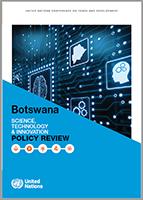
Botswana seeks to transform into a high-income, industrialized economy by 2036 as part of its Vision 2036. Harnessing science, technology and innovation (STI) is recognized in that vision and national development plans as critical for achieving structural transformation of the economy and achieving the sustainable development goals (SDGs).
The STI Policy Review provides an assessment of the state of STI capacity, the national system of innovation (NSI) and the effectiveness of the 2011 National Research, Science, Technology and Innovation (RSTI) Policy which enable Botswana to harness STI for development. It identifies key strengths and weaknesses and proposes recommendations for addressing critical weaknesses.
The review finds that Botswana has improved its STI capacity in the past two decades, but progress is too slow and needs to accelerate significantly.
The country has important strengths that it has built since independence. But fundamental weaknesses in the NSI and STI capacity persist. They relate to education and skills, institutional governance of STI, establishing national STI priorities, financing for STI, the R&D system, support to the private sector, STI indicators, monitoring and evaluation, foresight and technology assessment capacity, international partnerships and various sectoral and SDG-related sustainable development challenges.
- Chapter 1 outlines Botswana’s development trajectory.
- Chapter 2 covers indicators of STI capacity in Botswana.
- Chapter 3 looks at the national system of innovation.
- Chapter 4 addresses the national Research, Science, Technology and Innovation Policy.
- Chapter 5 looks at harnessing new technologies for economic transformation.
- Chapters 6 to 11 cover sectoral and SDG-related sustainable development challenges of transforming agriculture for food and nutritional security; health and well-being; inclusive growth and social development; sustainable tourism; sustainable and inclusive mining and industrialization; and STI for environmental sustainability.
- Chapter 12 addresses international cooperation and partnerships in STI.
- Chapter 13 provides a synthesis and summary of recommendations.


